Benny Lewis's Blog, page 93
November 21, 2014
Stop Allowing Excuses to Run Your Life!
In my inbox I see hundreds of people sharing their language learning woes every day, and in person I meet many people everywhere I go who struggle to start a language. There are many reasons they give, some of which are valid, but many times they are just excuses.
Nothing reminds us more of this than when we see people with genuine setbacks in life, who go ahead and outperform people who definitely have it easier. Today I want to share such a story, and it comes to us from Angela who interviewed Yang Meng Heng to share his story with the world, and how he learned his languages despite a major setback.
Take inspiration from this, and remember that no setback is ever big enough to stop you from achieving your dreams. Over to you Angela!
————
Yang Meng Heng, or Jesse as his foreign friends call him, is a 22-year-old college student from a small village in Yunan, China. He’s a champion swimmer, a published author, and an inspirational speaker. He speaks English, Cantonese, and Spanish fluently – in addition to his native dialect and Mandarin Chinese.
Not impressed yet?? Jesse also has no arms!
As a child, Jesse was in an accident that completely changed his life. One Sunday afternoon, 7-year old Jesse was playing alone in some fields near his village home. Curious and excited, he found an electric water pump. Wondering at what he thought was a plastic water bottle on top of the pump, he reached out and touched the machine. It would be the last time Jesse would use his hands to reach for anything.
The ungrounded machinery gave Jesse an electric shock that nearly took his life.
I still remember reaching for that white bottle, and then nothing – it was like a shadow.
Hours later Jesse awoke in a hospital bed, his arms burned so badly that the local doctors decided amputation was the only way to save his life. At such a young age, Jesse had no idea what he was about to lose.

‘People take their arms for granted,’ Jesse says explaining all of the ways he had to adapt to his new life, including learning how to walk again. Jesse’s parents pushed him to be independent. ‘My parents were very wise. They told me that my life is my own, they can’t control my life, they can’t live my life for me.’ Despite the many challenges he faced, he went on to continue with his childhood aspirations of becoming an athlete, competing as a swimmer in the Chinese Paralympics.
In fact, no matter what dream he wanted to go after, Jesse wouldn’t let his disability get in the way. He is living proof that “reasons” (or… excuses) are not what stop us from accomplishing our goals.
So let’s meet Jesse!
ANGELA: You have accomplished so much for someone so young, only 22 right? What has pushed you to work so hard?
JESSE: I think in most people’s mind, people like me are not supposed to seize their future or seize a destiny. They don’t expect us to do anything great. But after the experience I had with the accident, I can’t take my life for granted. It’s a gift.
ANGELA: I think a lot of people, including myself, see someone who is different, maybe with a deformity, and we don’t really know how to act around them. Do you think people treat you differently?
JESSE: No. Well – for a while they did, but by the time I was in high school I had gotten out from under that shadow.
ANGELA: So what changed?
JESSE: I changed myself. How you see yourself, is how others see you.
ANGELA: What first got you interested in public speaking?
JESS: When I was in high school, a speaker came to my school, and his speech motivated me, but it wasn’t the content of the speech that motivated me. I just saw this guy, who was pretty normal, giving this speech, and he got all this applause from the audience, and I thought, if he can do this, why can’t I?

ANGELA: What is the message that you want to get across to the students you speak to; if they just took one thing away from your presentation, what would you want that to be?
JESSE: To break out from limitations, to stop believing they can’t do something, and to start working so that they can.
ANGELA: What kind of advice do you give to Chinese students when it comes to learning English?
JESSE: I tell them to recite English articles and to imitate native English speakers. I think imitation is a great way to learn a language. Its how we learned as children.
ANGELA: Even though all Chinese students have to study English, from my experience, most cannot communicate very well, so what makes you different from the rest?
JESSE: I was more specific in my study. I set goals. For example, during my first semester of college, I had a goal to become friends with at least two foreigners, which I did. I would eat with them and hang out with them, all while speaking English.
ANGELA: I think one of the more important – probably the most important part of learning a target language is to speak to native speakers of that language.
JESSE: Yeah, sure, of course.
ANGELA: Unfortunately, I think a lot of language learners worry about what natives will think of them.
JESSE: Basically they’re scared.
ANGELA: Right, so I want to compare that to your situation. You say that people stopped treating you differently because you saw yourself differently, and I think the same is true of how people will see language learners. If you see yourself as this annoying language learning leech, sure, you might bother some people. But if you are going at this with the real intention of being friendly to people and building a relationship with someone while also improving your language skills, I think that will come across as well.
JESSE: I would definitely agree with that.
ANGELA: What was your schedule like when you were learning English? What was your routine?
JESSE: I got up at 6 am every morning and recited English articles for half an hour. Then I would run to school. For the rest of the day I would spend every second I could studying, even when I was on the toilet. I would sit with a book in front of me and recite more English articles.

Angela getting caught following Jesse’s advice.
ANGELA: When someone wants to accomplish something, like they want to learn a language?
JESSE: But they just want! They don’t act!!
ANGELA: Right, so they give “reasons” for why they can’t learn a language. What excuses do you hear the most and how do you respond?
JESSE: The truth is, there’s only one reason: they are lazy. But there are three excuses I hear all the time.
I don’t have time: Squeeze time. Use rubbish time to learn a language, like when you’re in the bathroom or on a bus.
I’m not talented at learning languages: Every person possesses the talent to acquire a language. How could they pick up their mother tongue, if they didn’t have the “talent”?
I don’t have the opportunity to learn: People create opportunity for themselves. You can’t wait for it. You’ll be waiting forever.
ANGELA: What do you think is the biggest struggle people face with language learning? Why do so many people fail?
JESSE: They don’t have the real desire. They don’t have the courage. Success or failure depends on how much you want it. You have to want it badly enough to work for it.
“When you want to succeed as much as you want to breathe, you will be successful.” – Eric Thomas
ANGELA: What is the one lesson that you want people to learn from your story?
JESSE: I want people to know that they can break away from limitations. It’s easy to make excuses. It’s painful to do the work. But you have to make yourself feel a little pain to get the results that you want.
Now some of you may read this and then think, well there must be something special about Jesse. You are right! There is something special about Jesse. He had two very obvious “reasons” not to be successful: minus one right arm and minus one left arm.
Anyone can take his or her given circumstance and find “reasons” to give up on what they want to achieve. Jesse didn’t even need to look for excuses. They were right there staring him and his whole world in the face.
It would have been easy for Jesse to use his circumstance as a reason not to try, but he didn’t. Jesse chose not to let his circumstance run his life. So the “reasons” that made it hard for him to succeed, did not stop him from graduating high school with the highest grades in his county, it didn’t stop him from being a champion swimmer or a public speaker, it didn’t stop him from speaking 5 languages, and it won’t stop him from achieving any of his other dreams.
As a child, faced with the loss of two limbs, Jesse grew with a perspective on life that has helped him to achieve success in all facets of life. But we don’t have to wait to experience incredible loss in order to have incredible motivation. No matter what challenge may be in your way, remember, excuses are just excuses.
Here’s a video of Jesse introducing himself:
And this is a video of Jesse writing with his feet at one of his speeches:
If you’d like to learn more about Jesse, check out his blog!
And if you’d like to hear more from Angela you can read more at her blog!
The post Stop Allowing Excuses to Run Your Life! appeared first on Fluent in 3 months - Language Hacking and Travel Tips.





November 18, 2014
Skype Language Lessons Crash Course Part 1: How to prepare for your first Skype language session
Skype language lessons are the future!
For almost three years now, I’ve no longer been going to a specific country to learn its language, and instead I use spoken sessions on Skype (or other video/audio tools that I’ll discuss later) to bring up speaking skills up a notch, so that when I do reach the country I can use my time there to enjoy the culture and get more practice, without being bogged down with studying.
I find Skype to be a superior means to learn a language in most cases, since it’s cheaper, more accessible, has huge variation for who you can speak to, and you don’t even need to leave the comfort of your own home. If you do happen to be in the country where your target language is spoken, private teachers can be hard to come by, and much more expensive – which is why when I was learning Mandarin in China, I still got a lot of my lessons on Skype (through itaki – my favorite resource for finding Skype partners online).
And keep in mind, that I’m a location independent full-time traveller. So you are hearing it straight from the horse’s mouth – you don’t need to travel to learn a language!
A crash course in maximizing your Skype language lessons

But what do you do once you’ve found someone to practice their language with you on Skype? How do you maximize your sessions? I’ve been getting these questions a lot lately, and I’d like to give them some serious attention.
Now that I’m back into consistent Skyping again myself, I’ll be documenting my favourite Skype-learning strategies, and I’ll discuss on the blog various parts of the puzzle in this modern tool available to language learners. So, in coming weeks, I’ll be writing a new series of Skype-learning posts, in which I’ll cover:
* How to find the best Skype teacher or exchange partner for your own personal learning interests
* How to work with a teacher during a Skype session
* Advantages of online lessons: Best use of the latest technology not available to in-person lessons
* What to do after your Skype session so that the next one is better
Each one of these deserves a discussion in itself, so to really delve deep, I’ll talk first in this post about what to do before your Skype session begins.
Getting into the flow of starting a new language
If this is your first ever Skype session, or even if you had spoken the language some time back but haven’t practised it for a while, then you will be missing a lot of momentum, and that will make your first Skype lesson harder than it could be.
I made a big mistake when relaunching my Mandarin recently, and I decided that I was going to hop on Skype as the first thing I did to get back into things. You can see in this video that I looked like I was run over by a truck. I was finding the lesson so stressful, and I felt exhausted afterwards.
Whenever I’ve made this mistake, I’ve collapsed into my bed after the session and needed to take the rest of the day off from brain-melting exhaustion. Yikes!
Don’t make the same mistake I made –the “Oh shit I have a Skype lesson in 5 minutes!” approach to Skype-learning definitely won’t get you the maximum benefit.
I have done it right in other projects though, so let’s get into that now.
Build up momentum before you speak – listen to easy content

The reason my recent first lesson was hardest wasn’t because of my own lack of vocabulary (there are ways around that), but actually because everything that my teacher was saying was sounding like gibberish to me. It had been way too long since I had even heard the language spoken.
The same issue comes up if it’s your first lesson. You don’t want the first time you’ve ever heard the language to be someone asking you a question directly. This is a recipe for the conversation switching to English, and if you ever do that I want you to picture me wagging my finger disapprovingly at you!
I think it’s important to build up a little momentum – you don’t need to go into silent period mode and relinquish all contact with other human beings for years, but maybe listen to some content in that language for a half an hour before your class.
When I’ve done this before my sessions, the change has been dramatic. My third, fourth and other sessions in Chinese were way less stressful because I eased myself back in just before. My second session was just as bad as my first, so it wasn’t just the first-session-blues at play – it was starting my day with a Skype session and the pressure involved in that, without giving myself a little momentum first.
What you listen to shouldn’t be too intimidating though. I highly recommend you check out language learning podcasts that offer slow-spoken audio options (as your teacher or language partner would speak to you), since you can select the lower levels where they speak in a way similar to how a patient teacher would. For this I really like the Innovation Language podcasts, which start with a slow-speaking beginner series, and then pick up the pace and the complexity as you get better.
Learn vocabulary that will help you speak during the conversation
A mistake a lot of people make before trying to use their language with another human being is to do something like studying chapter 1 of their language course. Generally these introductions to the language are not good ways to prepare for real conversations, and will only make sense to you or be effective after you’ve completed the entire course.
Instead, I suggest you hop on Omniglot to find key phrases for your target language, and learn how to say things that are likely to come up in a first conversation like “Where are you from?” “Pleased to meet you” and pleasantries like “Sorry” and “Thank you”.
Make sure you look up words in advance related to basics about yourself – your country’s name, your profession, your age etc. in the target language, and have them written down if you can’t commit them to memory.
Finally, and especially if you already know the basics, hop on Memrise and go through one of their courses for your target language, so you have used interesting mnemonics to keep key words ready to launch at the right time.
When your first practice call is just about to start!

If you’ve listened to some audio to get your ear back in the flow, and you’ve revised the words you are more likely to say, or have them written down somewhere, then just make sure everything else is working well so that you don’t have unfortunate issues during the call.
If you are logged in to Skype, then test the connection speed between you and your conversation partner (click the connection icon when you have their profile open in Skype, before calling them), and if you can make the connection optimal, do so by closing any programs that take up your bandwidth. A slow connection is a major pain in the neck when you are trying desperately to understand the other person.
If you haven’t used Skype for a while, use its test call option to make sure your mic and audio settings work. Since I travel a lot, I do this pretty much before every Skype call I have. Otherwise, the first conversation you have will be mostly you apologizing for your crappy computer and abysmal Internet speed (can you guess how my first Mandarin relaunch conversation began…?)
Make sure you have tabs open on your computer screen to dictionaries, translators, and word lists you may need while you talk, or a separate document ready in another window with your phrases at the ready, and you can start the call!
Finally, don’t be afraid to tell your language teacher or exchange partner exactly what you want to do. Feel free to say “Today I just want to practice introducing myself” or “I want to talk for 10 minutes about my job and for you to correct my mistakes.” The more specific you are with them about what you’d like to accomplish during that call, the better they’ll be able to help you.
And we’ll cover how that call can go, and how to choose the perfect partner in upcoming posts.
How do you prepare just before your Skype calls? Let us know the comments below!
The post Skype Language Lessons Crash Course Part 1: How to prepare for your first Skype language session appeared first on Fluent in 3 months - Language Hacking and Travel Tips.





November 14, 2014
Improving Mandarin for Singapore visit [video update]
Since I’ve decided to reboot my Mandarin learning project, I got into regular Skype lessons and was aiming to use it while in Singapore. The video below shows this process of de-rusting my old Mandarin and reaching this first minor milestone!
//www.youtube.com/watch?v=hNxWF4JlRAA
An overview of the video:
00:00 – 01:27 My first lesson back into Mandarin after many months not speaking it. I could barely understand some basic words!
01:27 – 03:04 Reading a prepared script describing getting back into Mandarin.
03:04 – 03:31 Clips of the Singapore Language Lab and people using their language, and me speaking several languages with them at the end
03:31 – 04:43 After leaving Singapore, in Indonesia this week, my teacher Rachel on italki telling me how several of her students apply my advice to speak their target language.
04:43 – END My answer to Rachel’s question about pacing myself when I am intensively learning languages, and wrapping up the video
———
So far so good! I have a long way to go, but I’ll be taking my time and will let you know when I have another milestone and will share my progress for that point!
I also hope you enjoyed seeing that quick preview of the Language Lab in the middle of this week’s video – I plan to continue holding such events in cities around the world as I visit them. Maybe see you at one?
Let me know your thoughts on the video in the comments below. Cheers!
The post Improving Mandarin for Singapore visit [video update] appeared first on Fluent in 3 months - Language Hacking and Travel Tips.





November 6, 2014
Singlish: The Singaporean English creole [video interview]
For the next few days, I’m in Singapore to host a language lab to train people to speak their target language on day one, and to sign copies of my book. I’m also using this visit to a country that speaks English as an official language, to investigate its other unique linguistic opportunities.
In this visit, I’m going to practise some Mandarin, but I started my trip by investigating Singlish.
Singlish
When most people think of learning a new language, they tend to imagine official languages of countries. There are of course many languages (like Quechua) that get often neglected by governments, artificial languages and a whole spectrum of many other possibilities.
As well as these well defined separate “languages”, I’m also very much interested in dialects, creoles and pidgins. You can almost never sit an exam in them, finding materials to learn them can be quite hard, and their use is even frowned upon in many cases, but when you speak to people in the same way they themselves speak to their friends and family, it breaks down barriers and allows you to make local friends so much easier.
I noticed this was the case with “Singlish” – a very unique English creole – when I visited Singapore a few years ago. I invited Jade Hu, a local who reads my blog, to give us her thoughts on the subject. You can watch our chat in the video below.
//www.youtube.com/watch?v=lC8nM75AqUk
For further information about Singlish, definitely check out:
A great answer on Quora to the Singlish vs “proper English” debate
The Wikipedia article on Singlish
TEDx talk on Singlish
Best of Singlish words/phrases
The Coxford Singlish dictionary
Examples of Singlish
For someone with some experience in Chinese, you will notice especially how Singlish has a unique sentence structure, influenced in part by the Chinese dialect Hokkien (and Cantonese).
Blog reader Marcus gave me the following examples, with Chinese comparisons, and even threw in his introduction written in Singlish:
So last time from very young, I already like to learn many things about many languages. Like you know hor, my father is Teochew and mother Foochow, but at the same time they know a lot of other dialects like Hokkien, Cantonese and a bit of Hakka, Henghua. Ah I tell you orh, we all like to say things like,
“why you so liddat??” (为什么这么这样)
“faster leh!” (快点!)
“don’t anyhow say people lah!” (不要乱讲别人啦)
“how can one?!” (哪里可以的)
“he say he you can end early meh??” (他说他能早放工吗?)
“you say people, say yourself!” (讲别人,不如讲自己)
“never die before” (equivalent to 没有死过)
“why come out so much pattern” or “so much pattern like badminton” (tactics used in a (possibly) scheming or irritating way to get what one wants are too many)
and occasionally add in some dialectal or non-English words like,
“why always bojio (Hokkien for not asking someone along or inviting someone) one?!”
“also bo bian what, he dunno how shiok the event was, just anyhow say cannot make it..”
————–
I hope you enjoyed today’s video – I look forward to sharing more local insights in my travels. Anyone in Singapore who reads the blog, I hope to see you this weekend at the book signing or workshop!
Everyone else, let me know your thoughts on learning local dialects/creoles/pidgins or your experience with Singlish specifically, in the comments below!





October 29, 2014
Juggling Languages: The Balancing Act That All Polyglots Must Perform
Polyglottery is a bit of a balancing act.
Because we only have so many hours in a day, we can’t learn all languages. But when you have the itch for language learning like I and so many other polyglots do, you sometimes can’t help but to take on a new language challenge even though you haven’t mastered or even reached fluency in all languages you’ve already taken on.
And that’s okay. Not everyone needs to have all their languages at a mastery level, even if they may want it. It’s “ideal”, but not realistic in the short-term. In my case, my upcoming travels have always had to be the priority, so a previous project had to get shelved temporarily or permanently.
This is a problem all polyglots face. Maintaining fluency/mastery level in your languages takes work, and if you’re always adding a new language to your study list… well, then you’ll have to start making tough decisions about where your language priorities lie. I sometimes joke that I’m just as talented at forgetting languages as I am at learning them.
The upside is that when the time comes, you can come back to languages you’ve put time into but still not reached an ideal level in yet, and that’s what I’m going to do now!
For the next year, among other goals, I’ve decided I want to bring up Mandarin into my list of fluent languages
Where I stand now with my Mandarin
I did my intensive Mandarin project three years ago, and I ultimately reached a level of about B1 – a respectable level, but not fluent.
Since then, I’ve definitely used my Mandarin on several occasions, speaking with readers during my book tour, hanging out with friends at conferences, and similar situations. But I have not been actively maintaining the language or studying it regularly, as my italki teachers have been happily reminding me…
And as I’ve told you before, you have to actively maintain your languages or else you will lose them. Hence, the balancing act. Since I’ve decided my next mission is to bring Mandarin up to a fluent level, this has to change today.
My current Mandarin level: ~A2

This week I had a Skype chat in Mandarin to mark the starting point of my Mandarin level-up mission, and also to figure out What is my level now?
Based on that conversation, I’d say that my level has slipped down from a B1 to about an A2. I can hold a conversation, use words and phrases spontaneously, but I’m hesitating a lot, having to look up a lot of words (that I didn’t have to look up before), and I definitely lack the confidence I had at the end of my previous project. As you can see, I spent most of the session facepalming myself 
But have a listen for yourself – and let me know what you think. What level would you say I’m starting from here?
For those of you who don’t speak Mandarin, I’m trying to explain the plot of “Game of Thrones”, and doing a pretty miserable job at it. 
My mission target, mini-mission and short-term milestone
One thing I want to do with this project is to lay out all my plans and strategies so you all at home can maybe apply the same to your own level-up missions.
So for me, now that I have a starting point, the next step is to specify a real target and a real deadline.
My ultimate target is to add Mandarin to my list of fluent languages. But I like to break my projects into smaller mini-missions, so I’ll pick a smaller target I can aim for in the short term.
Since I’m going to Singapore next month, I’ll start with a mini-mission of being able to have comfortable casual conversations within a week or two. This goal is “de-rusting” my Mandarin, and remembering keywords that I used to know to allow conversations to flow a little better.
And this makes for a great deadline – the end of my time in Singapore (November 10th).
For me, this mini-target means that when someone greets me in Mandarin, I’ll be able to respond relatively quickly, and have the words for a brief casual encounter at the tip of my tongue. (I’m not expecting to be fluent by November 10th, just to be confident at basic initial conversations again)
My strategy and study plans
Obviously I’m going to be implementing my Speak from Day 1 approach, as you can see by the fact that Monday was Day 1 and I’ve already spoken 
But let me get into a bit more detail:
Daily Skype Sessions
My plan is to have conversations in Mandarin daily, and to record as many of them as I can so that I (and you!) can see how it progresses.
I’ve already jumped on italki and booked a session a day for the next few weeks. Here’s a look at the next 7 days for instance:

Study sessions between Skype sessions
I’ll be listening to Chinesepod, as before, and testing out Chineseclass101 to improve my listening skills. I’ll also be trying apps like Skritter to get started on improving my reading skills over the long term. I’ll list my favourite resources here on the blog, and in my email list more frequently.
I also have a single book I’m travelling with, Yufa – A guide to Chinese grammar. Since I already have a base in Chinese, I don’t need a simplified book with lots of pictures for beginners, but can handle more “dry” (and by now familiar) grammar explanations to help me remember Chinese sentence logic that bit better. I’ll revise and improve my vocabulary with Anki and Memrise.
Essentially, with my Skype sessions and study sessions combined, I expect to spend about 2-3 hours per day devoted to Mandarin from now until November 10th. We’ll see how far I get between now and then! Once I’ve gotten to that point, I’ll figure out my next mini-mission from there (based on whatever the biggest problem I’m facing at that time is).
How this level-up mission is different from my intensive projects
I’m excited about this mission because I haven’t done anything like this on the blog before. Most of my missions have been intensive, full time projects where I’m starting from scratch and sweating like hell to get as far as I can go.
This one is different. I haven’t written so much about how to bring up or revive a “fallen” language before, and I think this is a problem a lot of language learners face, so I’ll be very interested to share my insights with you on how I’m tackling the problem – and also to hear your suggestions for me!
Also, unlike most of my past missions, I’m not doing it full time, and I think that’s a scenario that, again, a lot of you out there can relate to. It will be interesting for me to see how fast I can improve with just part-time (but still daily) language immersion, spread over the longer term.
RECAP
My long term target: Reach fluency and add Chinese to my list of fluent languages (spoken/listening as well as reading/writing)
My current level: ~A2 (spoken/listening only)
My current mini-mission: Be able to have basic conversations with Mandarin Speakers in Singapore
My mini-mission deadline: November 10th
My strategy: Daily study sessions, Skyping, and use of apps. Approx. 2-3 hours per day.
Let me know in the comments – What are your struggles in reviving a slipped language? What level would you say is my starting point, based on the audio sample? What strategies would you recommend for my mini-mission of boosting my level to get it as close to what it was about 3 years ago, as quickly as I can?





October 24, 2014
Mandarin level up mission (Singapore edition)
After devoting the majority of this year to meeting aspiring new language learners to give them my best advice face-to-face, I can now get back to focusing on my own goals!
I am a strong believer in intensive missions at the start of language projects – it skyrockets us forward at what is undoubtedly the biggest hurdle for most people – the beginning. Once you have momentum and a base in the language, you will have the confidence to bring it somewhere beyond that project.
It’s the core of my three-month missions. I always say that there is only so much you can do in three months, and that needs to set the stage for your longer term goals.
This is what I did with my Mandarin three years ago. I took on one of the most notoriously “difficult” languages in the world (it’s not that bad), aimed really high, and got pretty high after a few months. It was by no means the end, but it was an excellent beginning, ending with me having a basic conversational level in Mandarin.
With other projects taking most of my time since then, my level has gone down a bit, but I am eager to get this on my list of fluent languages some day. As such, I am going to devote my next project to seriously improving my Mandarin again!
Part 2 of Benny’s Mandarin: Singapore edition

Unlike in my previous projects, I’m not really aiming for an end-goal. That plan-of-action got me to a good level, but consistent long-term practice will take it from here.
Instead, I’ll be looking to hit various milestones.
The first one involves a trip I’ll be making to Singapore in two weeks for a quick book signing and for a 3-hour intensive language academy (both open to all).
The last time I was in Singapore, since it was just after my time in China, I used the opportunity to practise my Mandarin and had a blast using it on unsuspecting Singaporeans, well used to white faces, but not used to hearing Asian languages coming out of their mouths!
For the next two weeks, I’m going to wipe the dust off my Mandarin and try to push it back up to something close to the level it was three years ago, and get talking! If possible, I’ll record a video of my experience and some of my Skype sessions before – make sure to stay tuned to my new Youtube channel for that!
In my next update on this mission, I’ll share my strategy and plans for regular practice.
Singlish and Singaporeans
As well as Mandarin, I’m really interested in documenting some lesser-known (to the west) English creoles in my travels. Singlish is a very interesting one, and if I can find someone to interview I’d like to upload a video discussing how unique it is.
Singaporeans, let me know what your recommendations are, and who I should invite for an interview on the Fluent in 3 Months Youtube channel! And I hope to see you at the language academy & book signing!
——–
What are your strategies for shaking off the dust from your languages? And how are your own long-term language improvement projects coming along? I will have other milestones I’ll share on this long journey in months to come, and hope you’ll enjoy reading along on my shiny new blog!





October 20, 2014
FI3M Just Got a Fresh Coat Of Paint
I’m sure you can’t help but notice that your favourite language learning website is looking a bit…
FREAKIN’ AMAZING?
SLEEK AND SEXY-FIED?
LIKE THERE’S SOME SORT OF ORGANIZATION?
Well, I’m glad you noticed 
Today is a huge day for me because it represents a culmination of months and months of hard work and tough decisions, as well as loads of technical web site stuff I won’t bore you about.
But I’m extremely excited, and really very proud of what my team and I have been able to accomplish behind the scenes for all these months despite our extremely busy schedules.
So I’m going to go ahead and share with you the down-and-dirty details of the beautiful new site you see before you – exactly what we’ve done, why we’ve done it, and how we’ve crafted this new site design, every step of the way, by asking ourselves how we can better help struggling language learners.
Why we decided to change the site
I read every email I get, and I try to keep reader requests and suggestions in mind whenever I can to make the site better.
So I couldn’t help but notice that over the past year or two I’ve gotten more and more emails describing my site with as having a certain “charming chaos” to it.
And then there are the emails I get asking me questions like “How do you use Skype for language learning?”
This tells me something important: Vital articles are apparently hard for new members to find.
And then I also get emails that just say something like “Dude, you need to redesign your site.”
So yeah, I got the message.
The original site design has 30+ articles right on the home page. A younger Benny thought this was a brilliant idea, because then readers would have loads of pieces to choose from, could dive right in, and learn so much about language learning! But it didn’t work that way. What I learned from all your feedback is that for new readers, the home page is overwhelming, and for long-term readers, those 30+ posts aren’t enough to answer all your questions.
My team made this brand new site with all this feedback in mind.
Here’s why the new FI3M site design kicks ass
1) Every page now has its own purpose
The Home page is for new visitors who don’t know where to start. Rather than throwing a chaotic (but charming) swarm of 50 posts at them, they get the basic rundown of the site. Clear and easy.
The new Blog home is the home page for FI3M regulars (like you!). You can now see any site news at the top, then scroll down to see a bunch of the most recent and popular posts at a glance. I’ve also added new features that you’ve been asking for via email for ages: You can now browse for articles by category. (Sorry that took so long). And of course you can still search by keyword as well.
You can go ahead and bookmark the Bloghome page now so you can skip the step of clicking to enter the Blog from the homepage.
2) The new site is Smartphone / Tablet / Mobile friendly
That’s right! Honestly I’m embarrassed it took me this long to make a mobile-friendly site because I am such a techie, but now it’s here. You can now officially read FI3M articles on the go. Try it out!
Actually a few months back I found out that someone made an unofficial Android app (free) that lists all new FI3M blog posts, Facebook statuses, tweets, etc. And now that my site works on phones, it’s actually useful – so go ahead and download it to keep yourself updated!
3) The new site is cleaner and sleeker
We’ve eliminated the clutter, made the design simpler and more attractive, and just generally made it all shiny and new.
4) The new site is faster
Less clutter = more speed.
5) We feature the email list more prominently
People tell me consistently that one of their favourite parts of FI3M is the free crash course they get for the first week, and especially the highly researched Friday email they get every week with the Internet’s best language learning news. It makes sense to put one of the best aspects of the work my team and I does at the forefront.
And last but not least…
6) STILL no pop-ups, no advertisements taking up the sidebar (or anywhere else on the site for that matter), no crappy Buzzfeedy “#4 will shock you” clickbait, no sponsored posts, no selling out to make a quick buck – none of this, ever.
Just pure language learning inspiration and helpful articles.
Of course!
Thousands of hours and a small army of very smart people built this site for YOU
I want to stress that our team has worked our asses off and thought long and hard about how to make this site better, less distracting, easier to navigate, and more fun to use for you.
We really hope that you enjoy it. Definitely let me know in the comments and in your emails what you think.
Oh yeah – one last thing
Ironing out the bugs
My site is huge, with hundreds of articles and a couple of dozen plugins – so things may look weird for a few days.
If you see something strange, or have any feedback on ways the look can be improved, email us to let us know (under Support: Technical Issues). We’ll fix it!
In about a week, everything should be looking amazing. Until then, if you see a problem, help us out by sending a message.
Benny and Team FI3M
Since I was extremely busy on the book tour over the last months, the real people who brought this new design to life are shown below, so I’d like to give each of them a huge thanks!






From left to right, that’s me, Lauren Cutlip, Bálint Kőrösi, Dávid Csere, David Masters, Julian Juenemann.
Without you, the site would have stayed stuck in 2010 for quite some time!
Looking forward to your feedback, as always, in the comments, and I can’t wait to share some really nice articles with you on my brand-new shiny site 





October 16, 2014
#Polyglotproblems: Things you only need to worry about when you speak more than one language

A “First world problem” is a minor inconvenience for people who don’t have to deal with any pressing concerns – an advantage of living in a richer country or having a rich lifestyle. As such, it’s hardly something to genuinely complain about.
Along the same lines, a Polyglot Problem is an inconvenience you only have to deal with when you speak multiple languages! It’s hardly grounds for saying your life is unfair, because you do have that wonderful advantage that gave you the inconvenience after all. 
I’ve been seeing the hashtag gain grounds on twitter, Facebook and even Instagram, as well as get posted on other blogs, so I figured I’d share my own “complaints” as well as some of my favourites from elsewhere. Enjoy!
Some of Benny’s polyglot problems
When you bump into someone you’ve already met, and have that awkward few seconds where you can’t remember what language they speak and are waiting for them to say “Hello” or “How are you?” first so you can figure it out
When someone discovers that I speak another language, and demand that I “say something in [that language]”. I find this to be an uninspired and dull question. What would they say if I told them to say “something” in their mother tongue? If I want to be a smartass, I usually just reply with the single word algo/quelque chose/rud éigin/东西/io/irgendwas…
When you meet another polyglot, and have to spend the first few minutes deciding which of your five common languages you are going to be speaking in (Here are Judith’s thoughts on that!)
You get woken up with a phonecall, and are too tired to remember what country you are in and if you should answer with “Pronto?” or “Allo?” or “Bueno”… This is a trio of #firstworldproblems, #polyglotproblems, and #worldtravellerproblems
You casually mention the word “polyglot” to someone not into language learning, and they think you have multiple lovers
Signing up for a new profile on a site and selecting the “Languages I know” area and they only have two or three options! How am I supposed to pick just three? Couchsurfing has a more generous limit of 10 languages on your profile, but I still eventually had to remove English so that I had room for other languages!
When you receive emails on a daily basis that change language every sentence, since people think that’s how polyglots write and feel comfortable reading

— Benny Lewis (@irishpolyglot) May 15, 2013
From 10 Problems Only a Language Lover Will Understand on the Transparent blog
When you procrastinate studying a language… by studying another one
When all you can think about is which language you’ll learn next, even though you can’t keep up with the languages you’ve already learned
When people talk about you in a foreign language assuming you don’t speak it… but you do
When you begin parler en multiple idiomas at the same tiempo
When someone asks you why you’re learning that language, as if it’s impossible just to learn a language for fun
From twitter
i have too many keyboards activated and it takes forever to scroll through to get to the language i want! UGH #polyglotproblems — Lily Liu (@xlilyliu) December 23, 2011
When you see a movie called ‘Agora’ and think its a Portuguese or Brazilian movie…but it’s really about ancient Egypt… #PolyglotProblems— annette⚡️ (@annettecarinaa) January 27, 2012
When you try to think of a word and can only remember it in another language. #polyglotproblems — Polyglot Problems (@polyglotprobs) January 30, 2014
Only I would get involved in a 10-minute grammar argument that spanned four languages. #PolyglotProblems — Justin Sanak (@JustinSanak) February 24, 2012
From PolyglotProblems on Tumblr



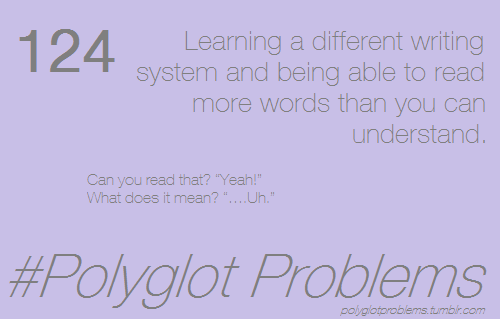
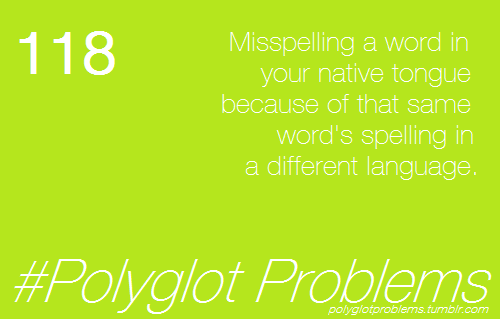
———-
I suppose my favourite polyglot problem was when I was attending the Polyglot Gathering in Berlin this year. Many people had t-shirts that said what languages they speak, or badges that listed their languages. For some, the list of languages was so vast that they couldn’t fit it on the badge! A very unique problem to have indeed 
Richard Simcott’s solution to the problem was to just have two words on his badge: “Try me!”
What #polyglotproblems have you run into in your language learning adventures? Share them with us in the comments!





October 8, 2014
How do you get spoken practice in a less common language, when you can’t find native speakers?
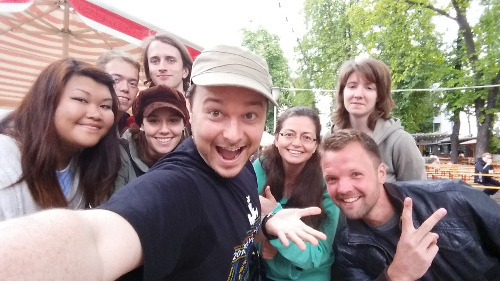
On Monday (13th October 2014), I hop on a flight to Thailand – after which I’ll be hanging out in Asia for several months. Those of you subscribed to the email list will find out precisely where we go next, and what we’re doing, before anyone else 
But as you know, I’ve been very busy this year on the international book tour in several countries. This has been a chance to meet aspiring language learners and offer my answers to any questions that may come up.
There was one stop though, in Hartford, Connecticut where someone asked me a question about how to learn a language when there are no speakers nearby. I, of course, suggested that they get on italki and find native speakers for some “virtual immersion” via Skype. But this person had already tried that, and couldn’t find any native speakers on italki or on any site for that matter!
So, how do you get language practice when native speakers are genuinely hard to come by?
Cue: Brandon, the Language Encourager
This also happened to be the one stop on the tour where I got to meet our Language Encourager in person for the first time – Brandon – who helps me with all your language questions (just send them as a reply to any of my emails, after you sign up. We are happy to help with any language learning woe… we’ve heard them all!)
Brandon actually lives in New York, but wasn’t around when I made it there, so he drove to meet us in Connecticut instead.
So when I was asked by a language learner how to get language practice when you can’t find a native, he put up his hand and said that he actually had a good answer to that question, and I let him take over.
Simple idea, but very effective: Find other learners
Brandon initially had the same issue with his project to learn Icelandic. It’s a country of over 300,000 people, but they are not so likely to be on language learning sites that offer free exchanges, since their English is already likely to be very good.
He tried to find natives to practise with, but hit a brick wall no matter where he went.
And then he tried something else – he searched instead for other non-native learners of the same language. The numbers suddenly went up dramatically! He had his pick of dozens of people he could Skype for practice. Maybe they didn’t grow up speaking the language, but while Brandon needed to get momentum he could speak with people who were at the same level as him or much higher.
It turns out the Internet has quite a lot of high level Icelandic speakers, willing to help you out!
My own story: Learning Spanish from anyone but Spaniards
The way I learned my first foreign language successfully, long before Skype, actually relies on the same principle, even though the lack of native speakers wasn’t the problem (I was living in Spain after all). It’s that they spoke too fast and used phrasing that was too complicated for me.
I actually learned the majority of my Spanish (initially) from French, Brazilian, Italian and German students who were also learning the language (they were living in Spain as part of the Erasmus student exchange program). They were more likely to speak slowly to me, and as fellow learners they knew the words I was more likely to know, and could rephrase things simpler than a native speaker could.
In fact, native speakers can sometimes be terrible at helping you learn their language if they don’t have teaching experience. They may not know why a term is phrased a particular way – and may not be aware of how complicated something is from the learners’ perspective.
This is definitely true in Spain. No matter how many times you tell many Spaniards to speak slowly, they will not realize they are doing it. It’s discouraging for an absolute beginner!
Try to get practice with those the same level as you or higher
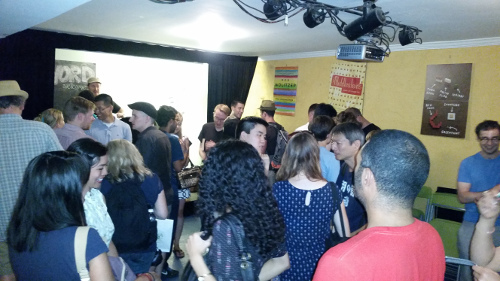
With all this being said, you still need a good strategy when choosing who you practice with. As a beginner, I would be very flexible for languages that are quite restricted in finding speakers online, because any practice is better than no practice. And remember: you are practising and not studying. Imperfection is to be embraced. 
The great thing about being a beginner is that pretty much everyone with any experience knows (a little or a lot) more than you do, so everyone can be your teacher!
For instance, are you learning Irish, or Cherokee, or Quechua, or Maltese? These are languages that may have their fair share of native speakers, but they can be notoriously hard to pinpoint in person and even through online practice (Don’t forget that you can listen to them through streamed radio, and read articles in these languages online easier than you think)
But once you cast your net wider and include fellow learners – the world is your oyster! Use the language option on italki (and untick native speaker), or select it as a language they speak on Couchsurfing for in-person meet-ups, or use any other language or social site and search for speakers and be flexible and you may even get better practice than you would with a native, as a beginner.
You can also get in touch with groups of fellow learners on sites like Meetup.com, or find learners in other ways, such as those who came to my book signings, who got loads of language practice with one another, as you can see in the photo (At Word bookstore in New York City)!
This approach of practising with non-natives is of course how people can consistently practice languages like Latin, Klingon, Esperanto and other special interest languages!
And of course, you do this so that when you do get time with a native (if you can find them), you can truly take advantage of it thanks to all that practice you’ve gotten in advance.
Let me know – have you tried out this technique before? Have you noticed your level improve when you practice with other learners? Tell me in the comments below.





October 7, 2014
Forget “learning a language.” Focus on forming the habit.

Meet Maneesh Sethi.
Maneesh is a friend, an inventor, and a fellow language learner (he has been a DJ in Berlin, and spoken on stage in Italian, among other things) with a very particular passion…
For years, he has been obsessed with solving the problem of maintaining motivation that we all face in trying to achieve our long-term goals.
In language learning, motivation is a huge barrier to success and often a constant struggle. The eternal question is how can we be as dedicated to our language practice on week 60 as we were on week 1?
Maneesh has taken a scientific, practical, and a bit extreme approach to answering this question. He actually once hired a girl to work alongside him and slap him in the face whenever he got distracted by Facebook. He wanted to see how the social pressure (peer beside him) and physical pain (slap in the face) would change his habits.
Today, Maneesh is on the blog to talk about his scientific approach to forming new habits, and how he invented a new device (already featured on the Colbert Report, ABC news and reaching it’s Indiegogo intial funding aim in a single day) to train his brain in a very unique way.
He takes productivity problems very seriously.
Over to you, Maneesh.
———————-
Why is learning a new language so freaking hard?
We imagine how empowering and liberating it will feel to travel the world, visit exotic locations and speak to locals in their native tongue.
We endure the monotony of audio and video courses. We attend expensive classes. We spend hours on complicated software. It’s all in the hope that one day we’ll become fluent… or at least proficient.
Yet for 95% of us, none of this training ever “sticks.”
At the end of our study, we usually still don’t know enough to have a basic, two-sided conversation with anything that isn’t prerecorded. (Remember high school Spanish class?) It’s frustrating and discouraging — and it also perpetuates the myth that learning a new language gets “harder the older you get.”
But here’s the good news: It’s not your fault.
The truth is, most people will never learn a new language not because the language itself is too difficult or they’re not smart enough… but because they can’t get themselves to practice the language consistently.
They haven’t learned how to assimilate language learning into a habit.
What is a Habit?
Habits are the key to behavior change.
When you form a habit, you won’t have to get “motivated” to do something. You won’t have to use willpower or “force” yourself and get it done.
Think about how it feels to go to bed without brushing your teeth. It feels wrong. You feel like your day isn’t complete — and you’ll even drag yourself out of bed to do it, despite being tired.
Why?
Because brushing is so deeply ingrained into your daily routine that it actually requires more willpower to NOT brush than just to brush! It’s a deeply formed habit — and you rarely miss a day.
How much more progress would you make if you could retrain your brain to treat language learning the same way? How much faster could you master the basics and move on to fluency if you practiced your new language 365 days in a row without missing a day?
You’d be unstoppable. And you’d definitely be able to hold a casual conversation without grabbing the dictionary every other word.
It all starts with changing your behavior and forming new habits.
This idea of making language study a habit in my life was on my mind a lot back in Florence when I was learning Italian.
And so I’ve spent the last two years rigorously researching behavior change and figuring out how to make goals like language learning, working out or waking up earlier a natural part of my day, rather than an eternal struggle. Since then I developed Pavlok — a wearable technology to help you build new habits (and break bad ones). Pavlok currently commits you to fitness, waking up on time, and being more productive — but we are currently working on integrating Duolingo and other language learning tools so it can commit you to forming the habit of learning a language.
In this article, I’m going to distill all of our best research and teach you the step-by-step process for reprogramming your brain and making language learning so efficient that it becomes part of your everyday life, automatically.
If you’ve ever felt like learning a new language was a chore, and that you weren’t making the progress you’d like, this article is for you.
Keep reading!
Demystifying the Habit Formation Process
The habit formation process contains three main components: Cue, Routine and Reward.
The habit process in motion
It starts with a cue. Think of the cue as the spark that sets a behavior in motion.
The cue initiates a routine. The routine is the actual behavior that you perform in response to the cue. Over time, this behavior becomes a habit.
Then, the routine is given a reward. Usually, the reward is something pleasurable we give ourselves for carrying out the routine that reinforces it. But beware: many rewards are subconscious. We don’t even know we are rewarding ourselves.
Cue. Routine. Reward.
Let’s say you’ve formed a bad habit of over-snacking while watching TV after work.
You come home at 7:30 and Criminal Intent is on — so you flip on the TV. That’s the cue.
What happens next? Well, you flop down on the couch… and suddenly you realize that you haven’t eaten since lunch. You’re starving, but also tired. You don’t feel like cooking — but there is a nice tub of Ben and Jerry’s in the freezer. You start to snack on that as you’re watching TV.
Now the routine has begun.
You’re watching one of your favorite shows, eating a tasty treat, and dopamine is firing like crazy. Then, your significant other comes in and starts watching TV with you. You have fun talking to them and really enjoy the together time. The entire experience is very rewarding.
Even without thinking about this process consciously, your brain is primed to do it over and over again. Good food, your favorite show, happy times with family. Who wouldn’t want more of that?
But ice cream for dinner is a really bad habit. So how do you break the cycle?
The easiest way is to keep the cue and the reward constant, but swap out the routine you want to change.
In an alternate scenario, you’d still come home from work, turn on the TV and plop down. But instead of reaching for the ice cream, you’d substitute it with frozen berries.
It sounds simple, but there are a lot of complex factors at play here.
First, instead of depriving yourself by saying, “no more snacking” you’re acting in line with how your brain is already functioning. Eating the berries would still allow you to respond to the television cue with food. An added bonus is that the berries themselves are sweet and cold — which fulfills some of the tactile sensation from the ice cream.
Next, while watching TV and snacking on these berries, you’ll still get to enjoy quality time with your family — which reinforces the new behavior and helps it become habit.
Simply substituting a new routine in place of an old one, while keeping your cue and reward the same, is one way to build a new habit practically overnight.
Using Micro-habits to Learn a New Language Quickly
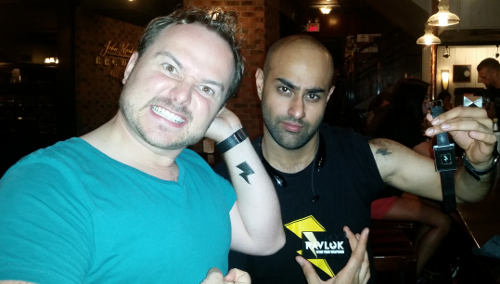
Turning ice cream into frozen berries is great… and it’s certainly a worthy behavior change.
But what about establishing more complex habits like language learning?
Habits that require you to utilize more cognitive function take much more effort — and that means your approach has to be different.
The secret lies in creating powerful “micro-habits” that catalyze your brain to perform difficult new behaviors, even when your conscious brain doesn’t want to.
What is a “micro-habit”?
Simply put, a “micro-habit” is the smallest individual action you can take to spur the execution of a new behavior and turn it into a habit. It’s similar to the concept of “mini-missions” that Benny uses whenever he learns a new language. You break down a large goal into a much smaller specific action.
In combination with proper cues and rewards, “micro-habits” can help anybody execute even the most complex behavior changes without having to endure the long periods of forced, sustained willpower expenditure that typically exhaust and defeat you before you reach your goal.
Imagine a world where it’s actually more painful NOT to complete a new behavior than it is to just do it. That’s what “micro-habits” create.
Setting up the “micro-habit”
Assume you want to build the habit of studying Spanish every day. How would that look, in practical terms?
Maybe your current approach involves “cram sessions” after work, huddled next to the vocab book until something else catches your attention, or until you pass out. How’s that working out for you?
These types of poorly planned approaches rarely work for those trying to make massive, consistent change. Distractions loom as soon as you open the front door. The dogs needs to go out. Your kids want to talk to you (the nerve!). Your significant other wants to talk about finances. And you just realized how tired you are. Como se dice “overwhelmed?”
It looks like you’re not going to get much studying done today. It has nothing to do with “motivation” or “willpower” — it’s simply a matter of time, energy and mental systems.
Now, let’s take another crack at installing the same language learning habit, but instead of using the traditional “just do it” mentality to power through the discomfort — let’s use a “micro-habit” to install this new behavior.
What the step-by-step “micro-habit” process looks like:
STEP #1
The first step to installing a great “micro-habit” is choosing the correct cue to remind you of your goal and initiate the new behavior (this is all part of the 3-Step habit formation process we covered above).
In this instance, the cue should be something extremely simple and completely unavoidable, such as setting an alarm on your phone for the exact same time every day that says, “Open Duolingo.”
Put the ringer and vibrate on. Make sure that you don’t miss the cue.
STEP #2
The next step is creating a meaningful routine that encourages you to execute the new behavior.
In the past, the behavior you tried to execute was complex and time consuming. In order to check off “study Spanish” on your daily to-do list, you had to:
Get off work/get home
Turn off all distractions and get into study mode
Open whatever book/program/app/website you’re using and reacquaint yourself with where you left off
Struggle through the lesson, mentally exhausted
Remember to do it again tomorrow (otherwise you’ll forget what you just learned)
It’s a tiring process.
This is where 99% of people fail to create a new habit — and this is where the idea of “micro-habit” comes into play.
From now on, I want you to forget about how tired you are after work. Forget about remembering vocabulary. Forget about conjugations.
In fact…
I WANT YOU TO FORGET ABOUT LEARNING SPANISH ENTIRELY.
Your new goal is not a nebulous notion like “study Spanish every day” — your new goal is one, single action.
All I want you to do is open the Duolingo app.
No, that wasn’t a typo.
Every day, you’ll see the reminder when your phone goes off.
When you see that reminder, all you have to do is OPEN the application. That’s it.
You don’t have to study. You don’t have to remember anything. You can simply open the app and close it. This should take you less than 5 seconds.
That’s it. That’s your new routine. If you can do that every day for a week, it counts exactly the same as actually studying Spanish. Hooray!
To make sure you follow through, add some accountability: Every day you aren’t able to open Duolingo, you’ll have to invoke some sort of negative reinforcement as a penalty — and have an accountability partner check in to keep you honest.
Have your significant other or a willing friend ask you every day after work “Hey, did you open Duolingo today?” If the answer is “no,” you owe them $50. No exceptions.
Of course, you may not have a good accountability partner. Or you may choose not to have one so you can cheat occasionally with no guilt. It’s for people like you that I invented the Pavlok app. It works as a custom API that detects when you check into the app to give instantaneous non-cheatable accountability. It lets you choose a referee, and use non-cheatable accountability methods like GPS, API integration or even heart rate monitoring to ensure you hit your goals. (We are releasing this early for Fluent in 3 Months readers — get updated here).
In other words, it knows if you haven’t opened Duolingo today, and it penalizes you accordingly. After one or two $50 penalties for something that requires literally NO work on your part, your brain will get the message quickly.
So how does merely opening an application result in forming the habit of studying Spanish?
This ridiculously simple, seemingly dumb action is actually initiating a bunch of highly sophisticated psychological triggers behind the scenes:
Setting the bar so low that it literally requires NO effort to complete a task means that your ability to complete the task goes WAY up. The easier something is, the less willpower/motivation it takes to perform the action.
By intentionally setting a super easy goal, you’re purposely creating an environment that’s structured to give you consistent success and positive feedback on a daily basis. This repeated success builds confidence. Even if you’re only opening an app, doing it 7 days in a row feels great since that was your goal for the week.
MOST IMPORTANTLY: Intentionally setting a ridiculously simple goal and achieving it over and over again begins to agitate your brain after a while. It eventually becomes impossible NOT to follow through with the entire habit, since the tiny action has already set the entire process in motion.
Sure, the first few days, you might simply open the app and close it again.
But as the week progresses, your brain begins to REJECT the idea of opening the app without working out.
The thought process might sound something like, “This is stupid. I’m already in the app. Maybe I’ll just study a few vocab words.”
Before you know it, you’re watching Finding Nemo on Univision without subtitles, wondering where all the time has gone.
The next day, maybe you’ll go back to just opening the app — and that’s totally fine. However, after a week or so, it will make less and less sense to open it without actually doing some work. You will forcefully change your own psychology.
STEP #3
Now, you’re on a roll.
Your new cue is in place, the “micro-habit” is in full effect, backed by the threat of losing money. You’re opening the app and studying more — and the best part is, you’ve barely expended any willpower to do so.
Now, it’s time to activate the last part of the habit formation process by creating a reward to solidify the new “micro-habit.”
The reward can be something simple, like treating yourself to a massage or movie if you open Duolingo every day for a week. The actual reward isn’t important — the important part is pairing positive reinforcement with completing your goal every week.
This process is called “Push-Pull” motivation.
The negative reinforcement (the monetary penalty) “pushes” you to get started on your new behavior and creates urgency.
The positive reinforcement (the massage, movie, etc) “pulls” you through the behavior change week-to-week, and encourages you to keep going by rewarding you for consistently completing the “micro-habit.”
Properly implemented, the “micro-habit” system is a psychologically bulletproof strategy for starting new, positive habits.
“Micro-habits” work when you’re tired and just don’t feel like doing your new behavior. They work when you already have ten “pre-loaded” excuses ready to go for why you can’t get something done. They even work when you’re unsure of yourself, or lacking confidence in your new behaviors.
What about breaking bad habits?

Forming new, positive habits like language learning is great. But what about breaking deeply ingrained bad habits – wasting time, smoking, overeating and the like?
For that Pavlok uses a combination of classical conditioning and aversion therapy. Below is a brief description — but you can get our full use-case ebook here to explore in more detail:
First, set the bad behavior you want to eradicate
Then, Pavlok will begin to monitor your behaviour using sophisticated sensors and algorithms
When you perform that behavior, Pavlok will administer a mild shock that your brain begins to pair with the behavior
But don’t take the wristband off and try to “sneak in” a quick smoke outside or grab a cookie. Pavlok will soon contain sensors that can measure almost any variable or vital sign, including nicotine levels, blood alcohol content and glucose level. As soon as you put the band back on, you’ll receive a shock.
Don’t want to put the band back on? Fine. It will charge your bank account every day until you do.
I designed Pavlok to help you hold yourself accountable in ways that stick. When you implement these techniques, change is truly inevitable.
What To Do Next
The main reason most people have trouble changing their lives is because they don’t even know what real change feels like.
They don’t know how it feels to wake up at 5am, fully rested, and get work done.
They don’t know what it feels like to commit to learning a new language… and actually achieve fluency.
They don’t know how it feels to look at a pack of cigarettes, or a bottle of whiskey, and feel completely repulsed — even after 20 years of using.
They don’t know how it FEELS to be victorious over their own psychology.
But these aren’t just pipe dreams. Implement these psychological principles I used to create Pavlok, and finally you can become the best version of yourself.
We’ve prepared an ebook: Habit Change: Theory & Practice. Download it, and if you think this is a cool idea, we’d love your help in supporting our IndieGogo campaign!











